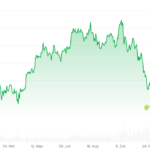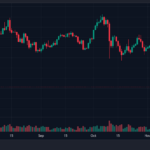- Bitcoin has declined 13% from its all-time high of US$123,640 (AU$188,620) and is currently trading near US$108,969 (AU$166,280).
- Analysts suggest that a potential cyclical floor for Bitcoin could form between US$93,000 and US$95,000 (AU$141,983–AU$145,037).
- Institutional accumulation remains robust, with corporate treasuries steadily increasing their holdings of Bitcoin and Ethereum.
Bitcoin has declined more than 13% from its record high of US$123,640 (AU$188,620) reached in August, slipping below US$110,000 (AU$167,940) and touching US$108,969 (AU$166,280).
Analysts at Bitfinex warn that the cryptocurrency could test a cyclical floor in the US$93,000–US$95,000 (AU$141,983–AU$145,037) range, which they identify as likely to provide strong support before a potential rebound in the fourth quarter.
While this breakdown carries technical weight, historical drawdown patterns and seasonality suggest the market is actually in the later stages of its corrective phase.
On-chain metrics support this view, with the Short-Term Holder Realised Price at US$108,900 (AU$166,260) acting as a key pivot, and exchange order flow indicators like Cumulative Volume Delta signalling that buyers are stepping back until stronger catalysts emerge.
The research arm of Bitfinex also highlighted weakness across altcoins, noting that ETH, XRP, ADA and DOGE have experienced double-digit losses. Ethereum fell 14% despite briefly reaching new all-time highs, while mid-cap coins such as CRO and PUMP saw gains driven by narrative-based rotations rather than new capital inflows.
The total altcoin market, excluding Bitcoin and stablecoins, is trading at US$1.54 trillion (AU$2.35 trillion), down 5.8% over the week, reflecting broad risk-off sentiment.
Related: Bitcoin Bulls vs. Bettors: $200K Dreams Clash with $100K Fears
Corporate Treasuries Driving Stability
Bitfinex analysts noted that institutional interest remains resilient, with corporate treasuries steadily expanding their Bitcoin and Ethereum holdings.
This support persists even as retail-focused altcoins fluctuate, and analysts suggest that September could mark a cyclical low. Structural drivers, including macroeconomic shifts, regulatory clarity, and potential US Federal Reserve rate cuts, may then underpin a recovery in the fourth quarter.
Despite the pressure on Bitcoin and altcoins, underlying market stability is evident. Historical support zones, ongoing institutional accumulation, and evolving regulatory clarity may set the stage for a year-end recovery in digital assets.
Further institutional adoption and regulatory developments, such as the CFTC Foreign Board of Trade framework and corporate adoption initiatives like BitMine’s ETH holdings, alongside state-level measures like El Salvador’s Bitcoin reserve strategy, provide additional structural support for a potential Q4 rally.
Related: Fed Minutes Reveal Split Decision as Bitcoin and Ethereum Shrug Off Initial Dip
The post Bitfinex Analysts Say Bitcoin Correction Deepens, But Signs Point to a Nearing Floor appeared first on Crypto News Australia.




